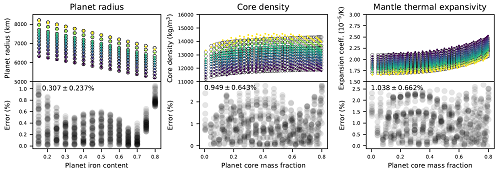Parameterisations of interior properties of rocky planets
- 1Institute of Geological Sciences, Freie Universität Berlin, Berlin, Germany (lena.noack@fu-berlin.de)
- 2Laboratoire de Planétologie et Géodynamique, Université de Nantes, Nantes, France
- 3Earth-Life Science Institute, Tokyo Institute of Technology, Tokyo, Japan
Observations of Earth-sized exoplanets are mostly limited to information on their masses and radii. Simple mass-radius relationships have been developed for scaled-up versions of Earth or other planetary bodies such as Mercury and Ganymede, as well as for one-material spheres made of pure water(-ice), silicates, or iron. However, they do not allow a thorough investigation of composition influences and thermal state on a planet’s interior structure and properties.
As shown in Figure 1, we investigate the structure of a rocky planet shortly after formation and at later stages of thermal evolution assuming the planet is differentiated into a metal core and a rocky mantle (consisting of Earth-like minerals, but with a variable iron content).
Fig. 1: Temperature (left), pressure (centre), and density (right) profiles for two example planet masses of one and two Earth masses considering
the hot temperature scenario and assuming di erent planet iron contents. From Noack and Lasbleis, 2020.
We derived possible initial temperature profiles after the accretion and magma ocean solidification following Stixrude (2014). We then developed parameterisations for the thermodynamic properties inside the core depending on planet mass, composition, and thermal state. We provide the community with robust scaling laws for the interior structure, temperature profiles, and core- and mantle-averaged thermodynamic properties for planets composed of Earth’s main minerals but with variable compositions of iron and silicates, see Figure 2.

Fig. 2: Comparison between interior structure model data (filled circles) and predicted data from our parameterised model (black empty circles)
for different planet parameters and planet masses, with colours ranging from 0.8 (dark blue) to 2 (yellow) Earth masses. Grey circles show the
individual errors. The mean error with one standard deviation is listed for each error plot. From Noack and Lasbleis, 2020.
The interior structure profiles, an online tool and the link to the repository including all Python Jupyter notebooks, that were needed to derive the scaling laws and figures of this study, as well as an implementation of the scaling laws in Python are available on the following website: http://geodyn-chic.de/tools.
The scaling laws make it possible to investigate variations in thermodynamic properties for different interior thermal states in a multitude of applications such as deriving mass-radius scaling laws or estimating magnetic field evolution and core crystallisation for rocky exoplanets.
References
Stixrude, L. 2014, Philos. Trans. R. Soc. A: Math. Phys. Eng. Sci., 372, 20130076
Noack, L. and Lasbleis, M. 2020, A&A, 638, A129
How to cite: Noack, L. and Lasbleis, M.: Parameterisations of interior properties of rocky planets, Europlanet Science Congress 2020, online, 21 September–9 Oct 2020, EPSC2020-947, https://doi.org/10.5194/epsc2020-947, 2020

